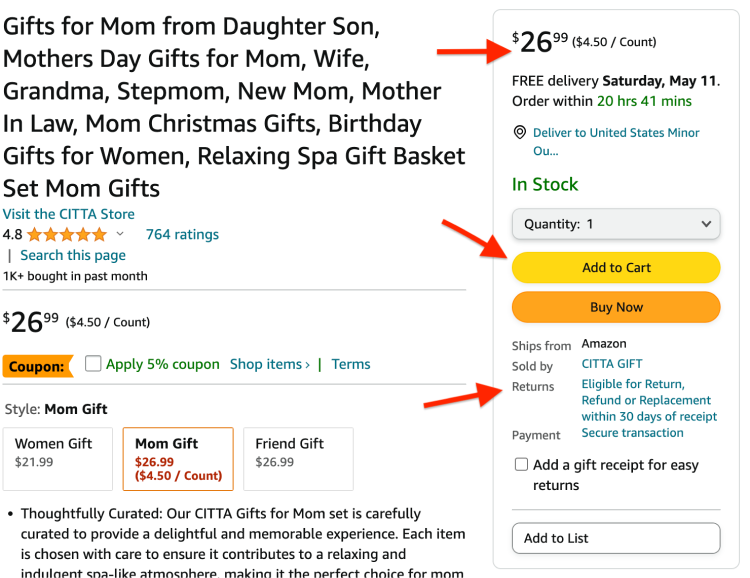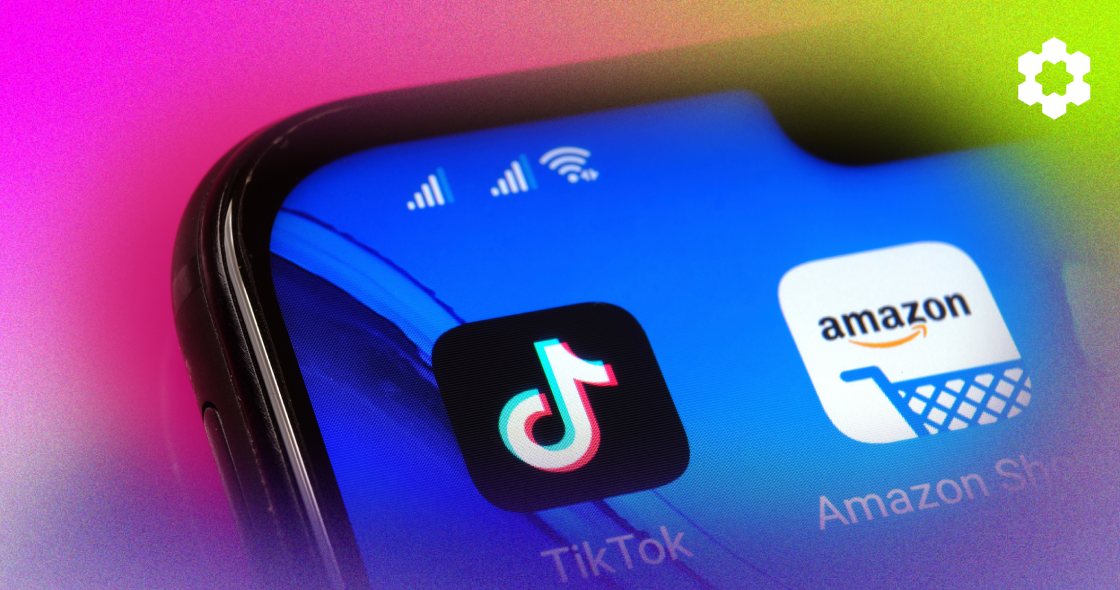Securing the coveted Buy Box is like winning a gold medal in the Amazon Olympics. The prime real estate that drives sales and visibility, catapulting your brand to the forefront of customer attention.
82% of all Amazon sales occur through the Buy Box. This means the Buy Box isn’t just a feature; it’s the beating heart of Amazon’s sales ecosystem.
So, when that golden opportunity suddenly evaporates, it may leave you in the shadows of obscurity. Many sellers reported a significant drop in sales within the first few days of Amazon Buy Box Suppression.
Today, we’ll demystify the enigma of Buy Box suppression on Amazon. We’ll delve into what it is, its profound impacts on your business, and most importantly, how to navigate the murky waters and emerge successfully.
So buckle up, as we uncover the secrets to staying visible and thriving on the world’s largest online marketplace.
What is Amazon Buy Box?
The Buy Box, also known as the Featured Offer, refers to the prominent section on an Amazon product page where customers can directly add items to their cart and make a purchase.
Buy Box Importance for Sellers and Customers
For sellers, winning the Buy Box is like striking gold. It means more visibility, more sales, and a better chance of success on Amazon. Think of it as having your product showcased front and center, making it more likely for customers to choose your offer over others.
For customers, the Buy Box simplifies the buying process, letting them add items to their cart or purchase with just a click or two. It’s convenient, it’s fast, and it’s what keeps them coming back to Amazon for more.
The Buy Box is a win-win for sellers and customers, making the shopping journey easy for everyone involved.
Given its pivotal role, understanding the dynamics of the Buy Box and the competition surrounding it remains a critical strategy for sellers aiming to optimize their sales performance on Amazon.
Buy Box Key Components
Imagine you’re browsing through Amazon, looking for a new gadget. You find the perfect item, and just below the product image, there’s a button that says “Add to Cart” or “Buy Now.” It’s like the VIP spot on the product page, where most customers make their purchases.
Aside from the prominent “Add to Cart” button, here are the other key components that make up the Buy Box:

- Featured Seller: This section showcases the seller whose offer is currently winning the Buy Box. It includes the seller’s name, feedback rating, and fulfillment method (e.g., FBA or FBM).
- Price: The price displayed in the Buy Box is typically the total cost of the product, including shipping fees. It’s crucial for sellers to competitively price their products to win or maintain the Buy Box.
- Buy New: Selecting this choice enables customers to purchase an item in brand-new condition.
- Buy Used: In certain cases, customers can buy a pre-owned item at a discounted rate.
- Add to List: This feature allows customers to add a product to a wish list, serving as a convenient way to save items for potential purchases later.
- Additional Offers: Customers can view other sellers offering the same product below the Buy Box. These listings may include price, seller rating, and fulfillment method.
- Buy Box Eligibility Criteria: Amazon’s algorithms consider various factors when determining which seller wins the Buy Box, such as price, shipping time, seller rating, and order defect rate. Meeting these criteria is essential for Buy Box success.
- Buy Box Rotation: In cases where multiple sellers meet the eligibility criteria, Amazon may rotate the Buy Box among them to promote fair competition and provide customers with options.
How the Buy Box Works
The Buy Box algorithm on Amazon is a sophisticated system designed to prioritize customer satisfaction by considering various factors.
While the exact Buy Box algorithms remain a mystery, factors like seller performance, pricing, shipping efficiency, and customer feedback play significant roles. Maintaining high standards with on-time shipping, competitive pricing, order defect rate, and feedback ratings are crucial for Buy Box eligibility. Customer satisfaction factors like response time, cancellation rate, and inventory availability influence Buy Box rotation.
Boosting Amazon Buy Box win rate also involves enrolling products in FBA, as this allows you to offer Prime shipping options. Overall, you can optimize your performance and increase your likelihood of winning the Buy Box by focusing on these key metrics and providing an exceptional customer experience. More on that later.
Why Sellers Lose the Buy Box
Aside from losing the price war, poor performance metrics and slow shipping speed, sellers can lose the Buy Box on Amazon due to:
- Inventory Availability: Sellers with insufficient inventory or frequent out-of-stock situations may lose the Buy Box as Amazon aims to provide consistent availability to customers.
- Product Authenticity and Condition: Sellers offering counterfeit items, products in the CRaP (Can’t Realize a Profit) list, or damaged goods instead of new, authentic products risk losing the Buy Box due to customer dissatisfaction.
- Violating Amazon Policies: Sellers who violate Amazon’s policies, such as manipulating reviews or engaging in prohibited marketing practices, may consequentially face Buy Box suppression.
The Impact of Amazon Buy Box Suppression on Sellers
When sellers encounter Amazon Buy Box suppression, it’s like hitting a roadblock on the highway to sales success.
Buy Box suppression means your product listing is not eligible to win the Buy Box. Instead of seeing that enticing “Add to Cart” button next to your item, customers might have to scroll down or click through multiple listings to find yours, significantly reducing your visibility and chances of making a sale.
Buy Box suppression can happen for various reasons, such as pricing issues, poor seller metrics, or selling restricted products. Whatever the cause, the result is the same: fewer sales and a frustrating experience for sellers who rely on the Buy Box for maximum exposure and conversions.
But with the right strategies and adjustments, you can overcome Buy Box suppression and get back on track to success.
It’s all about understanding the reasons behind the suppression, making necessary improvements, and staying proactive to ensure your listings meet Amazon’s standards and regain Buy Box eligibility.
5 Common Factors That Lead to Buy Box Suppression

The factors that commonly lead to Amazon Buy Box suppression can be categorized into several key areas:
1. Price
Competing on price is a significant factor in winning the Buy Box. Amazon favors sellers who offer competitive prices compared to similar products. If your price is significantly higher than your competitors, it can lead to Buy Box suppression.
For example, if Seller A offers a product for $20 while Seller B has the same product for $15, Seller B will likely win the Buy Box due to the lower price.
Unfortunately, when a listing gets suppressed on Amazon, many sellers often raise prices on other lower-cost marketplaces to regain the Buy Box. This results in lost sales for sellers and higher prices for consumers elsewhere.
On other ecommerce platforms like Walmart, sellers typically encounter lower fee structures than those on Amazon. Due to restrictive pricing policies, they can’t transfer these savings to customers, creating challenges for competitive pricing strategies.
Previously, Amazon imposed a price parity clause limiting sellers from offering lower prices elsewhere. Though removed in 2019 amid antitrust concerns, it was replaced by Amazon Buy Box Suppression, mirroring the old system’s effects. Consequently, consumers face inflated prices across all platforms, exacerbating the impact of inflation.
To stay competitive, monitor the pricing of your top competitors and adjust your price accordingly. Balancing this with your expenses is crucial to ensure that any price changes won’t negatively impact your profit margins.
2. Fulfillment Method
Amazon prioritizes sellers who use Fulfillment by Amazon (FBA) over those who fulfill orders themselves (Fulfillment by Merchant – FBM). FBA sellers benefit from Amazon’s fast and reliable shipping, increasing Buy Box eligibility. Sellers using FBM need competitive shipping and delivery times to avoid Amazon Buy Box suppression.
For instance, if Seller A uses FBA and can offer two-day shipping, while Seller B using FBM requires five days for delivery, Seller A will likely win the Buy Box. Some sellers view this as a tactic to pressure them into adopting FBA or paying for more Amazon ads, thereby forcing them to raise their prices to stay profitable.
3. Seller Performance Metrics
Amazon considers various seller performance metrics when determining Buy Box eligibility. These primarily include Order Defect Rate (ODR), Late Shipment Rate (LSR), and Valid Tracking Rate (VTR). Failing to meet Amazon’s performance standards could suppress your Buy Box eligibility.
Suppose Seller A has a high ODR due to late shipments and order cancellations, their Buy Box eligibility may be affected compared to Seller B with better performance metrics.
Discover the secrets to crafting an exceptional customer experience! Tune in to our exclusive interview with Tomer Rabinovich, a seasoned Amazon consultant with 8-figure success, on the latest episode of 6 Minutes with Carbon6.
4. Product Availability
Sellers should ensure their products are consistently in stock to avoid Amazon Buy Box suppression. If your product frequently goes out of stock, you may lose the featured offer for that listing, leading to lost sales opportunities.
Assuming Seller A’s product is frequently out of stock, Amazon may prioritize Seller B, who has better inventory management and availability.
SoStocked offers a range of inventory forecasting tools designed to enhance accuracy and prevent stocking out and overstocking. These features include Forecast Modeling, allowing you to create a 12-month inventory plan tailored to specific marketplaces and SKUs. SoStocked also employs Customized Velocity Calculations, incorporating various methods like Velocity Calculation, Manual Velocity, and Last Year’s Sales to project future forecasts. Seasonality considerations are also integrated, ensuring that seasonal spikes are accounted for in reorder calculations to avoid under-ordering.
5. Product Condition
The condition of the product plays a crucial role in Buy Box eligibility. Amazon favors sellers offering new, undamaged products over those who sell used or refurbished items. Consistent complaints about product quality or condition means your Buy Box eligibility may be suppressed.
If Seller A sells used items with poor customer reviews regarding product condition, Amazon may prioritize Seller B, who offers new products with better customer satisfaction.
6. Inaccurate Listings
If your listing quality score (LSQ) on Amazon falls below standards, such as containing inaccuracies in product details, low-quality images, or violating rules like title length requirements, you’re less likely to win the Buy Box.
Download our free LSQ Chrome extension from SellerTools to start your own Amazon listing optimization and minimize Amazon Buy Box suppression.
Overall, sellers need to optimize their pricing, fulfillment methods, performance metrics, product availability, and product condition to maintain Buy Box eligibility and maximize their sales potential on Amazon.
How to Win Amazon Buy Box
Winning the Amazon Buy Box involves a multifaceted approach that considers various factors influencing Amazon’s algorithm.
Most products, usually have several sellers eligible for the Buy Box. Amazon assesses these sellers to determine the portion of the Buy Box each should receive.
Therefore, one seller doesn’t receive exclusivity but obtains a share of the Buy Box. Nonetheless, Amazon does not distribute the Buy Box share uniformly. Instead, it prioritizes sellers who meet its criteria the most.
As a seller, the primary objective is twofold: first, to meet the eligibility requirements for the Featured Offer, and second, to implement Buy Box optimization techniques to secure the highest possible share once eligible.
Let’s delve deeper into both steps to grasp their significance in maximizing sales and visibility on Amazon.
Buy Box Eligibility Amazon Requirements
According to Amazon, certain products like books may not be eligible for the Buy Box feature. The eligibility for the offer can also vary depending on the product category. Various factors play a role in determining Featured Offer eligibility, which can differ across categories.
Below are some factors that may impact eligibility for the Buy Box status.
- Professional Seller Account: You must have an active Professional selling plan and an account in good standing.
- Competitive Prices: Prices featured in the Buy Box typically match or are lower than those of similar products available on the platform.
- In-Stock Inventory: When inventory levels are depleted, products may lose eligibility for the Buy Box.
- Fast and Timely Delivery: Prompt delivery is attractive to customers, who expect orders to be delivered promptly within the promised time frame.
- Product Condition: The Buy Box is for new or like-new items.
- Customer Satisfaction: When your Amazon account experiences a sudden surge in order cancellations or negative reviews, Amazon might suppress the Buy Box for your listings. We’ll explore customer satisfaction rates and other criteria relevant to the Buy Box algorithm.
Another important factor to consider is sales volume. The Buy Box may be awarded to top-performing sellers of a product. Therefore, if another seller sells more units than you, they are more likely to win the Buy Box, irrespective of pricing.
Best Practices for Improving Buy Box Performance
Significantly boost your sales and revenue by winning the coveted Buy Box spot with these tips.
1. Understand How the Buy Box Algorithm Really Works
Understanding how Amazon uses an algorithm to determine the Buy Box winner is crucial.
Contrary to popular belief, price isn’t the only factor for securing the Buy Box. While offering the lowest price is advantageous, it’s not a guaranteed win. As previously mentioned, various other factors play significant roles in the equation.
Relying solely on price competitiveness can lead to negative outcomes, fostering unhealthy competition among sellers. This race to the bottom is detrimental to all parties involved.
In short, gaining a competitive advantage on the platform involves analyzing Amazon Buy Box variables like account health metrics influencing the coveted real estate.
2. Consistently Hit Amazon’s Performance Targets
Amazon evaluates every seller based on certain performance targets ensuring everyone continuously delivers excellent customer service and satisfaction. Prioritizing them can boost your rating significantly.
Below are some of the most crucial metrics you should keep an eye on:
- Landed Price: It refers to the total price a customer pays, including the product price, shipping costs, and any applicable taxes. Sellers with competitive landed prices will likely win the Buy Box, as Amazon prioritizes offering customers the best value. Therefore, optimizing your landed price to remain competitive while ensuring profitability is essential for Buy Box eligibility.
- Order Defect Rate (ODR): Must not exceed 1%. ODR is put in place to make sure customer expectations are always met. To maintain a good ODR, aim to minimize your A-to-Z Guarantee Claim rate (due to customers receiving damaged or defective products), negative feedback rate (due to delivery delays), and credit card chargeback rate (due to the customer not receiving their order or refund).
- Valid Tracking Rate (VTR). Maintain a VTR higher than 95% at a product category level. You can do this by using shipping labels through Amazon’s Buy Shipping services and opting for a carrier found within Amazon’s logistics network. Ensure all relevant details—such as the carrier name, shipping service, and tracking ID—are entered into the Manage Orders page. Promptly confirm the shipment of an order and update its tracking information if necessary before it reaches the customer.
- Shipping Time. 14 days or less. Research indicates that 56% of abandoned carts are linked to delivery concerns. Since Amazon shoppers prioritize quick delivery, providing swift and cost-effective shipping options can enhance listing visibility and attract customers seeking expedited deliveries and competitive rates. Consider Prime and its efficient logistics which can offer a competitive edge in delivery speed.
- On-Time Delivery Rate. Greater than 97%.
- Late Shipment Rate. Less than 4%.
- Pre-Fulfillment Cancellation Rate. Less than 2.5%. This metric refers to the frequency of seller-cancelled orders (most likely due to product availability issues).
- Customer Response Time. Aim for less than 24 hours.
3. Generate Positive Reviews
Tracking the ratio of reviews to units sold over specific periods helps gauge customer satisfaction. Additionally, monitoring review quality is just as crucial – negative reviews can turn potential customers away. Analyzing star ratings and review content aids in identifying product issues for informed business decisions.
4. Stay on Top of Your Product’s Buy Box Status
Keeping tabs on the shifting Buy Box winners, particularly for competitive products, can feel overwhelming without automation.
5. Perform a Competitor Analysis
Watch your competitors’ pricing, fulfillment methods, and seller performance metrics. Understand how your competitors are performing. This can help you to price your products competitively and make other strategic adjustments. Lastly, experiment with dynamic pricing or bundling to find the optimal price point.
6. Optimize Product Listings for Better Buy Box Visibility
Continuously optimize your product listings to ensure they meet Amazon’s standards and provide a positive customer experience. This includes optimizing product titles, images, descriptions, keywords, bullet points, and A+ content.
7. Avoid Stockouts
Maintaining optimal inventory levels is key to sustaining a thriving Amazon business. Make sure that you always have enough units available to meet customer demand.
If you sell on multiple channels, syncing your inventory can prevent stockouts. Consider leveraging tools like SoStocked for inventory planning, which can offer customized recommendations based on sales history, demand forecasts, and seasonal trends.
Keeping your inventory stocked and synchronized across platforms is key to maximizing sales and providing a seamless shopping experience for customers.
Legal and Ethical Considerations in Buy Box Strategies
Legal and ethical considerations in Buy Box strategies revolve around fair competition, compliance with Amazon’s policies, and adherence to consumer protection laws. Some key considerations include:
- Antitrust Laws: Avoid engaging in anticompetitive behavior, such as price-fixing or collusion, which could violate antitrust laws and lead to legal repercussions.
- Price Gouging: Setting excessively high prices to take advantage of supply and demand dynamics, particularly during times of crisis, is unethical and may violate price-gouging laws in certain jurisdictions.
- Transparency: Provide accurate and transparent product information, including pricing, shipping costs, and availability, to ensure a fair and honest marketplace experience for consumers.
- Intellectual Property Rights: Respect intellectual property rights and avoid selling counterfeit or infringing products. Unauthorized use of trademarks, copyrights, or patents can result in legal action and account suspension.
- Customer Data Protection: Handle customer data responsibly and comply with data protection regulations, such as the General Data Protection Regulation (GDPR), to safeguard consumer privacy rights.
- Reviews and Feedback: Soliciting fake reviews or manipulating feedback to boost product rankings is unethical and violates Amazon’s policies. Focus on providing quality products and services to earn genuine customer feedback.
- Compliance with Amazon’s Policies: Familiarize yourself with Amazon’s policies, agreements and guidelines, as well as rules governing Buy Box eligibility, pricing, inventory management, and customer service. Violating these policies can result in account suspension or termination.
Prioritizing legal compliance, ethical conduct, and adherence to marketplace rules can help you maintain a positive reputation, build customer trust, and achieve sustainable success on Amazon.
Guide to Monitoring Your Buy Box Eligibility
Monitor each of your product’s Buy Box eligibility by following the steps below:
- In Seller Central, go to Inventory > Manage All Inventory
- Click the Preferences button on the top right-hand side
- Choose Featured Offer Eligible > Save Changes > See new column showing ASINs and eligibility
With this information, assess potential adjustments in pricing, shipping options, customer service, or other improvements. Utilize the insights gained to inform your strategy and determine your next move.
Dealing With Unfair Amazon Buy Box Suppression
Identify the Issue
Determine why your product is not appearing in the Buy Box. This could be due to poor seller metrics, pricing discrepancies, or inventory issues.
Address the Root Cause
Once you’ve identified the issue, take corrective action. This may involve improving seller metrics, adjusting pricing strategies, or resolving inventory problems.
Appeal to Amazon
If you believe the Buy Box suppression is unjustified, submit an appeal to Amazon. Provide evidence to support your case and explain why the suppression is unfair.
Monitor Performance
Continuously monitor your seller metrics, pricing, and inventory levels to ensure compliance with Amazon’s guidelines. Regularly review your Buy Box performance to identify any potential issues early on.
Seek Professional Assistance
If you’re unsure how to address Amazon Buy Box suppression or your appeal is unsuccessful, consider seeking seller support from professionals.
Proactivity in addressing Buy Box suppression and ensuring compliance with Amazon’s policies can minimize the impact on your sales and maintain a competitive edge on the platform.
Overcoming Amazon Buy Box Suppression
Winning the Buy Box is crucial for boosting sales and requires a strategy to preserve profitability. Avoid unethical tactics like pricing gouging or fake reviews, as while they may yield short-term gains, they harm your business in the long run.
Instead, optimize your pricing, fulfillment methods, seller performance metrics, product availability, and listings. These ensure Buy Box suppression prevention and help maximize your sales potential on Amazon.
Staying on top of Buy Box eligibility can be a daunting task. That’s where automation tools and Seller Central support services come into play. By leveraging our ecommerce solutions, you can monitor your Buy Box eligibility, avoid listing suppression, and boost your Amazon Buy Box win rate.
Overall, success on Amazon requires a multifaceted approach and ongoing monitoring of key metrics.








